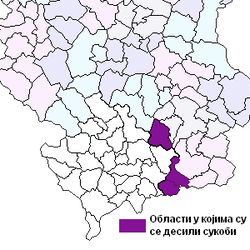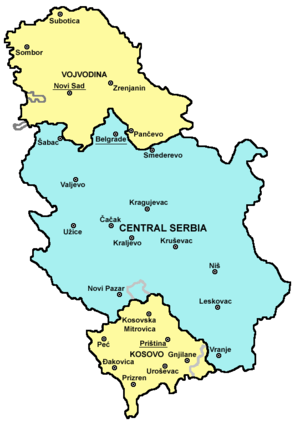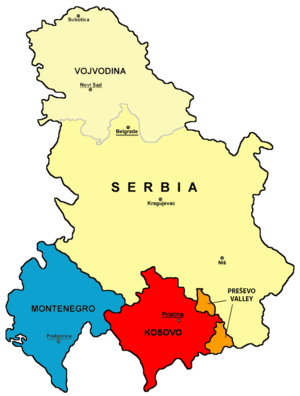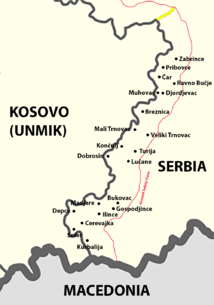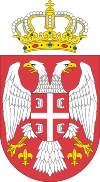تمرد وادي پرشڤو
| ||||||||||||||||||||||||||||||||||
تمرد وادي پرشڤو was a 1999–2001 armed conflict between the Federal Republic of Yugoslavia and the ethnic Albanian separatists[9][10][11] of the Liberation Army of Preševo, Medveđa and Bujanovac (UÇPMB).[12] There were instances during the conflict in which the Yugoslav government requested KFOR support in suppressing UÇPMB attacks since they could only use lightly armed military forces as part of the Kumanovo Treaty that ended the Kosovo War, which created a buffer zone between FR Yugoslavia and Kosovo, that the bulk of Yugoslav armed forces could not enter.[13]
خلفية
Before the insurgency Preševo Valley was home to approximately 100,000 people, of whom 70,000 were Albanians and another 30,000 Serbs. Albanians make up to 95% of Preševo, 40% of Bujanovac and 10% of Medveđa population. The region is sometimes referred to as Eastern Kosovo by Albanians. The Albanian-populated region became a part of Serbia in 1913، بعد حرب البلقان الأولى
From 1945 to 1946 Preševo and Bujanovac were a part of newly established Autonomous Oblast of Kosovo and Metohija inside the Federated State of Serbia. In 1946 they were transferred to Central Serbia in exchange for a part of Serb inhabited modern-day North Kosovo. During the breakup of Yugoslavia, on 1 and 2 March 1992 Albanians from Preševo Valley held the referendum about their future status in Serbia. The majority, 97% of voters demanded autonomy for the valley and the right to join Republic of Kosova. Serbian government rejected the referendum as unconstitutional and illegal.[14]
The Kosovo War was a parallel conflict between the Yugoslav Army and the Kosovo Liberation Army. It began in February 1998 and ended on 10 June 1999 when the Kumanovo Agreement was signed. According to the agreement, KFOR troops, supervised by the United Nations, would enter as a peacekeeping force, while Yugoslav military forces were to withdraw. It was agreed that the KLA would disband by 19 September 1999. According to the agreement there would be a demilitarized zone around Kosovo. Serbs could only use police squads with up to 10 members. This buffer zone was used by Albanian guerrillas for attacks against Serbian forces.[15] The Preševo valley conflict erupted in June 1999.
منطقة السلامة البرية
After Kumanovo Agreement was signed, 5 km (3 mi) deep demilitarized zone was established along Kosovo border. Length of the zone was 382 km along Serbian border. The purpose of this buffer was to prevent incidents between KFOR troops and Yugoslav army. At the same time, Air Safety Zone was set up. Its width was 20 km. Only lightly armed police force of up to ten members was allowed to patrol, so keeping order in this area was very hard. It was prohibited for Serbs to use planes, tanks or any other heavier weapons. GSZ became the heaven for drug trade and operations against Serb forces. Zone consisted of the following sectors:
- Sector C west – from Plav to border with Albania
- Sector A – from Rožaje to Medveđa
- Sector D – parts of Medveđa, Leskovac, Lebane and Vranje municipalities
- Sector B – from Medveđa to Preševo
- Sector C east – border with Macedonia to village of Norča[16]
UÇPMB
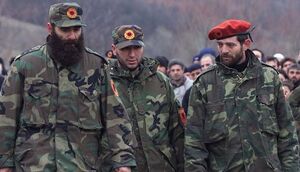
جيش تحرير پرشڤو ومدڤدزا وبويانوڤاتس (ألبانية: Ushtria Çlirimtare e Preshevës, Medvegjës dhe Bujanocit, UÇPMB) members were first seen during the funeral of brothers Shaqipi who were killed by the police in January 2000 in Dobrosin. They had around 1,600 active fighters and around 5,000 non-active. The Yugoslav government considered it a terrorist organization. The organization consisted of three zones. First was South zone commanded by Shaqir Shaqiri. After he was arrested in 2001, he was replaced by Mustafa Shaqiri. They had between 300–500 fighters. Center zone was commanded by Ridvan Qazimi, known as "Captain Lleshi", who had around 600 rebels. Lleshi was later killed in clashes near Oraovica. This zone was around Gjilan-Bujanovac regional road. In the north there was so-called Čar group, or North zone lead by Muhamet Xhemajli. The highest commander was Shefket Musliu auto mechanic from Končulj. Rebels mostly had mine throwers and other light weapons. Those weapons were transported illegally from Kosovo throughout border with Serbia. The biggest Albanian village in Serbia, Veliki Trnovac, was the rebel center. According to Serbian Security Intelligence Agency it was full of bunkers, as well as laboratories and storehouses for heroin. PMBLA was operating in following villages:
- North zone – Muhovac (command), Ravno Bučje, Pribovce, Zarbince, Suharno, Đorđevac, Čar
- Center zone – Veliki Trnovac (command), Breznica, Mali Trnovac, Dobrosin, Končulj, Lučane and Turija
- South zone – Bukovac, Gospođince, Mađare, Ilince, Depce, Masurica, Cerevajka, Sefer, Kurbalija, Šušaja, Karadak
Rebels were controlling all villages in GSZ sector B and C east except Cerevajka and Gramada.
التاريخ
1999
After Kosovo Liberation Army disbanded according to the peace agreement that ended Kosovo War, its veterans and members founded Liberation Army of Preševo, Medveđa and Bujanovac in a village of Dobrosin. Their goal was the secession of three Albanian populated municipalities from Serbia and their annexation to Kosovo. Fighting between police and separatist began in June 1999 in the municipality of Kuršumlija, and later spread to Medveđa, Bujanovac and Preševo. The UÇPMB established many bases in mountains and plains around towns of Bujanovac and Preševo. Main center of militants was a village of Veliki Trnovac. Because of restricted movement in that area, police and army were unable to stop them. On 21 November two policeman were killed by land mine.[17] Serbs responded on attacks with more checkpoints and patrols. During 1999 rebels did not enter an open conflict with the police. Instead, they battled them with the mortars from the distance, so Serbs were unable to respond.
2000
Conflict escalated in 2000. On 16 January three Serbs civilians from village Pasjane were killed by rebels in a Ground Safety Zone on a road Gjilan – Preševo.[18] After the overthrow of Slobodan Milošević, the new government requested that NATO and KFOR suspend the demilitarized zone around Kosovo, in fear that a new war could erupt. Vojislav Koštunica wanted the US to reduce or disband the zone.[19] During November 2000, some Serb police retreated from the demilitarized zone after four policemen were kidnapped and killed and another two wounded.[20][17] That gave a chance to Albanians to take all villages the Serbs had left. After this events, Božo Prelević, one of Serbia's three interior ministers, said Serbian police would return to the zone "with all available means" unless the attacks end. On 24 November a KFOR-mediated ceasefire was agreed to.[21]
2001
On 5 February the fiercest fighting in the Preševo valley happened since the end of the 1999 Kosovo conflict.[22] The Yugoslav army exchanged artillery fire for several hours across the internationally imposed buffer zone next to the border with Kosovo.On 16 February near the border town of Podujevo seven Serb civilians were killed after Niš-Ekspres bus with refugees from Kosovo was blown up by PMBLA.[23] After that, on 7 March 2001, KFOR agreed to allow Serb military to reoccupy buffer zone (called "Ground Safety Zone") section by section. At the same time Albanian guerrillas started mutiny in Republic of Macedonia. During the March one-week ceasefire was agreed again, after four policeman were killed.[24][25] Army first entered the section on a border with FYR Macedonia (section C East), in order to stop illegal arms smuggling. Afterwards KFOR allowed Serbs to return to zones C West and A on 25 March, and zone D on 14 April. On 21 May Albanian commanders signed Končulj agreement and agreed to disarm, but many continued to fight. Last section was around Preševo (sector B).[26] On 24 May Serbian army entered the town, although Albanian fighters were attacking them. There, one of the rebel commanders, Ridvan Qazimi "Lleshi" was killed. It is not clear whether he was killed by police or by other insurgents. After Serb victory UÇPMB agreed to disarm. Some of its veterans joined newly formed National Liberation Army in Republic of Macedonia.[27] Around 400 guerrillas surrendered in order to get the pardon from the Yugoslav government. PMBLA chief Shefket Musliu surrendered to KFOR on 26 May.[28] Until August 2001 there were around 1,160 attacks on Serb police and civilians.
معركة أوراوڤيتسا
The Battle of Oraovica was a conflict between Army and Police of FR Yugoslavia and Albanian militant group before Serbs entered last sector of Ground Security Zone. Since the village was outside GSZ, Yugoslav forces were allowed to use heavier weapons, such as M-84 tank. On 14 May Yugoslav forces launched an attack on UÇPMB stronghold in this Albanian-populated place near the border with Kosovo. Fighting began on 14 May at 06.10 AM by an attack on Yugoslav forces. At 07.00 AM guerrillas attacked Serbian police and army again and fired three rocket towards the village. More incidents happened during the day until 08.00 PM. On 15 May Serbian forces captured Oraovica although UÇPMB attacked them at 02.15 PM.[29]
الأعقاب
About 400 Albanians surrendered to KFOR and another 150 to Serbian police. They were not charged for war crimes according to the Čović plan and Končulj agreement. Most of PMBLA members joined NLA's war in Macedonia, while others joined newly formed Liberation Army of Eastern Kosovo.[30][31] Because of lack of members LAEK isn't active.[32] Several attacks on the Serb forces and civilians were recorded after the end of the war.
After reoccupation of Ground Safety Zone, Serbia separated it into 3 sectors. The sector B is stretching from Medveđa to the border with Republic of Macedonia. It is controlled by 4th Land Force Brigade situated in the city of Vranje. There are about eleven bases in this area.[33] In 2009 largest military base in Serbia, Cepotina, was opened 5 km from Bujanovac.
In 2002 in Preševo, Medveđa and Bujanovac had 57,595 ethnic Albanians. However, they boycotted the 2011 census, so only 6,000 people were recorded. It is estimated that Preševo Valley today has around 50,000 Albanians.
الخسائر والتهجير
During the conflict, 18 members of the Yugoslav security forces were killed and 68 were wounded. Eight civilians were also killed.[34] Some of the deaths were caused by mines.[1]
In 2013, UÇPMB veterans erected a memorial with the names of 27 insurgents who were killed in the conflict.[35] A further 400 were reported to have surrendered to KFOR.[36] Seven ethnic Albanian civilians were also killed.[37]
Two United Nations observers were wounded, according to reports.[بحاجة لمصدر]
عنف 2002–2004
Low-intensity clashes continued over the next years. Chronology of most important events:
2002
- 20 May – bomb thrown on a house of ethnic Albanian in Preševo. Police said it is the fifteenth registered attack since March.[38]
- December – police patrol was attacked in Končulj
2003
- 26 and 28 January – police patrol attacked again in Končulj
- 4 February – bomb thrown on a Serb house in Levosoje
- 23 February – one Gendarmery member killed, two wounded in Muhovac by anti-tank mine
- 2 March – anti-tank mine found in Turija
- 10–11 August – attacks on a police with a mortar in Dobrosin
- 12 August – road Kuršumlija – Podujevo, police attacked
- 13 August – mine placed in Lučane
- 23 August – grenade thrown
- 27 August – police attacked in Dobrosin
- 12 September- police attacked in Depce, Rudnik, Madjare and Preševo
- 23 September – bomb found in a school in Bujanovac
- 24 September – police attacked in Dobrosin
2004
- 4 February – Security Intelligence Agency member Selver Fazlliju killed in Bujanovac
- March – bomb found in school in Preševo
Several attacks on army were recorded in this period, such as: attack on watchtower in Čarska kula, sabotage on the pillar through which is powered the base of near Dobrosin and the stoning of a military motor vehicle in the village of Lučane.[17]
هجمات 2009
On 9 July 2009, two members of Serbian Gendarmery were wounded after unnamed 'terrorists' attacked their Land Rover near the village of Lučane.[39] On 14 July bomb exploded near the entrance of a building in Preševo where ethnic Albanian member of Gendarmery lived with his family. His wife and son were injured. Minister of Internal Affairs Ivica Dačić described this attacks as a terrorist act.[40] Same night police conducted an operation on a border with Kosovo, cutting illegal arms smuggling to central Serbia. Minister Dačić also said they found large amounts of weapons and ammunition in village Norča near Preševo.[41] The Government of Serbia accused former Liberation Army of Preševo, Medveđa and Bujanovac high-ranking member Lirim Jakupi, known as "Commander Nazi". He was also wanted by Macedonia for attacks on police in 2005.[42]
أزمة النـُصـُب 2012–2013
In November 2012 monument to 27 killed PMBLA fighters was erected in Preševo's main square. Government of Serbia was against it, so they gave ultimatum to local government to remove it. On 16 May the deadline expired.[43] On 20 May Gendarmery surrounded the city with 200 men and started removing the monument with a bagger at 7:00AM. The operation was led by general Bratislav Dikić.[44] This crisis raised the tension in the Preševo Valley once again.
الهجوم على الجنود 2014
On 25 January 2014 a Norwegian citizen suspected to be Wahhabi member attacked Gendarmery in Preševo. He was killed in a crossfire with the police. His motive was unknown.[45]
ردود الأفعال العالمية
 ألبانيا – Prime Minister of Albania Ilir Meta said that the problem in the Preševo Valley should be solved through "dialogue and democratic means" and not violence. The dialogue should begin soon so that the Albanians are assured internationally recognized standards of human rights.[46] Albanian political leaders have called for expansion of the NATO buffer zone and an internationally supervised demilitarization of the valley, essentially extending Kosovo's protected status to southern Serbia. The Albanian government has, for the moment, condemned the violence and appealed to Kosovo's Albanian political leaders to distance themselves.[47]
ألبانيا – Prime Minister of Albania Ilir Meta said that the problem in the Preševo Valley should be solved through "dialogue and democratic means" and not violence. The dialogue should begin soon so that the Albanians are assured internationally recognized standards of human rights.[46] Albanian political leaders have called for expansion of the NATO buffer zone and an internationally supervised demilitarization of the valley, essentially extending Kosovo's protected status to southern Serbia. The Albanian government has, for the moment, condemned the violence and appealed to Kosovo's Albanian political leaders to distance themselves.[47] Albanian politicians in Serbia – Jonuz Musliu, head of Political Council for Preševo said that they are against armed confrontation with Serbian government.[48]
Albanian politicians in Serbia – Jonuz Musliu, head of Political Council for Preševo said that they are against armed confrontation with Serbian government.[48] جمهورية يوغسلاڤيا الاتحادية – The Yugoslav president, Vojislav Koštunica, warned that fresh fighting would erupt if KFOR units did not act to prevent the attacks coming from the UÇPMB.[49]
جمهورية يوغسلاڤيا الاتحادية – The Yugoslav president, Vojislav Koštunica, warned that fresh fighting would erupt if KFOR units did not act to prevent the attacks coming from the UÇPMB.[49] Kosovo Liberation Army – Hashim Thaçi has accused Belgrade of genocide against the ethnic Albanian majority in three Serbian towns.[50]
Kosovo Liberation Army – Hashim Thaçi has accused Belgrade of genocide against the ethnic Albanian majority in three Serbian towns.[50] ICTY – Carla Del Ponte announced the investigation on activities of PMBLA in Preševo Valley.[51]
ICTY – Carla Del Ponte announced the investigation on activities of PMBLA in Preševo Valley.[51] ناتو – NATO allowed Serb forces to enter Ground Safety Zone. NATO spokesman Jamie Shea said the alliance had spoken to leaders of the ethnic Albanian community in Kosovo about the situation, and warned them it would not tolerate any action that made it worse.[52] Secretary General of NATO George Robertson denounced ethnic Albanian insurgents operating in the five-kilometer wide "ground safety zone" along southern Serbia's boundary with Kosovo. Robertson describes the insurgent Liberation Army of Presevo, Medvedja and Bujanovac as "a handful of extremists who are trying to seek an over-action." But he says they won't get far.[53]
ناتو – NATO allowed Serb forces to enter Ground Safety Zone. NATO spokesman Jamie Shea said the alliance had spoken to leaders of the ethnic Albanian community in Kosovo about the situation, and warned them it would not tolerate any action that made it worse.[52] Secretary General of NATO George Robertson denounced ethnic Albanian insurgents operating in the five-kilometer wide "ground safety zone" along southern Serbia's boundary with Kosovo. Robertson describes the insurgent Liberation Army of Presevo, Medvedja and Bujanovac as "a handful of extremists who are trying to seek an over-action." But he says they won't get far.[53] روسيا – the Russian Foreign Minister, Igor Ivanov, described the situation in the area as very critical; he said urgent steps were needed to stop the violence from spreading.[52]
روسيا – the Russian Foreign Minister, Igor Ivanov, described the situation in the area as very critical; he said urgent steps were needed to stop the violence from spreading.[52] الأمم المتحدة – UN secretary general Kofi Annan said: "It is clear that it is the Albanians who are now the cause of these provocations".[54] United Nations Security Council condemned Albanian extremists violence in Southern Serbia.[55] The Security Council called ethnic Albanian extremists from Kosovo to withdraw immediately from the boundary zone.[19]
الأمم المتحدة – UN secretary general Kofi Annan said: "It is clear that it is the Albanians who are now the cause of these provocations".[54] United Nations Security Council condemned Albanian extremists violence in Southern Serbia.[55] The Security Council called ethnic Albanian extremists from Kosovo to withdraw immediately from the boundary zone.[19] الولايات المتحدة – USA was against secession of Preševo Valley. US officials also warned the rebels there will be no repeat of NATO intervention in Kosovo.[48] Secretary of State Madeleine Albright said that It is very important that extremists from both sides not be allowed to disrupt the situation further.[50]
الولايات المتحدة – USA was against secession of Preševo Valley. US officials also warned the rebels there will be no repeat of NATO intervention in Kosovo.[48] Secretary of State Madeleine Albright said that It is very important that extremists from both sides not be allowed to disrupt the situation further.[50]
انظر أيضاً
- 2000 unrest in Kosovo
- 2001 insurgency in the Republic of Macedonia
- 2004 unrest in Kosovo
- Kosovo independence precedent
- معركة أوراوڤيتسا
ملاحظات
- ^ Limited defensive aid
الهامش
- ^ أ ب "Mine kills Serb police". BBC News. 14 October 2000. Archived from the original on 10 August 2014.
- ^ أ ب Holley, David (25 May 2001). "Yugoslavia Occupies Last of Kosovo Buffer". LA Times. Archived from the original on 4 March 2014. Retrieved 27 December 2012.
- ^ "Archived copy". Archived from the original on 3 June 2012. Retrieved 25 May 2012.
{{cite web}}: CS1 maint: archived copy as title (link) - ^ "Rebel Albanian chief surrenders". BBC News. 26 May 2001. Archived from the original on 22 February 2014.
- ^ "British K-For troops under fire". BBC News. 25 January 2001. Archived from the original on 13 November 2013.
- ^ "Kosovo rebels accept peace talks". BBC News. 7 February 2001. Archived from the original on 22 February 2014.
- ^ Schonauer, Scott (26 May 2001). "Yugoslav troops advance in buffer zone, brace for backlash from top rebel's death". pstripes.osd.mil. Archived from the original on 8 August 2007.
- ^ "New ethnic separations in the Balkans". UNHCR News. 24 July 2001.
- ^ Kosovo Liberation Army: The Inside Story of an Insurgency, Henry H. Perritt
- ^ Reflections on the Balkan Wars: Ten Years After the Break-up of Yugoslavia, Jeffrey S. Morton, Stefano Bianchini, Craig Nation, Paul Forage
- ^ War in the Balkans, 1991–2002, R. Craig Nation
- ^ Morton, Jeffrey S. (2004). Reflections on the Balkan Wars. Palgrave Macmillan. p. 57. ISBN 1-4039-6332-0.
- ^ "Renewed clashes near Kosovo border". BBC News. 28 January 2001. Archived from the original on 22 October 2014.
- ^ "Албанци са југа Србије остају доследни референдуму из 1992". Politika. 1 March 2012.
- ^ "KLA future in the balance". BBC News. 7 September 1999. Archived from the original on 28 September 2013.
- ^ "SNAGE BEZBEDNOSTI DO KRAJA DANA U ZONI BEZBEDNOSTI". B92. 25 March 2001.
- ^ أ ب ت "Uhapšeni Albanci otimali i kasapili Srbe". Večernje Novosti. 4 May 2012. Archived from the original on 8 July 2012. Retrieved 27 December 2012.
- ^ "Ubijena tri clana porodice Nojic iz Pasjana". B92. 16 January 2000.
- ^ أ ب "Yugoslavia Wants Smaller Buffer". CBS news. 22 November 2000.
- ^ "Ceasefire agreed in southern Serbia". BBC News. 25 November 2000.
- ^ "Ceasefire agreed in southern Serbia". BBC News.
- ^ "Serbia offers talks with rebels". BBC. 6 February 2001.
- ^ "Kosovo i jug Srbije". Vreme. 22 February 2001.
- ^ "Serbia clashes halt as ceasefire begins". BBC News. 13 March 2001.
- ^ "Ceasefire agreed in southern Serbia". BBC. 12 March 2001.
- ^ "Operacija "Povratak"". AIM. 26 May 2001.
- ^ "Serbia never signed Končulj agreement". Politika.
- ^ "Rebel Albanian chief surrenders". BBC. 26 May 2001.
- ^ "Yugoslavia: Troops Win Tactical Victory in Presevo Valley". RFE/RL. 16 May 2001.
- ^ Eastern Kosovo is other name used by Albanians for Preševo Valley
- ^ "ALBANSKI TERORIZAM I ORGANIZOVANI KRIMINAL NA KOSOVU I METOHIJI" (PDF). Government of Republic of Serbia.
- ^ "Делује 40 банди". Večernje Novosti. 9 November 2003.
- ^ "SUSTINSKA AUTONOMIJA UNUTAR SRBIJE" (PDF).
- ^ "Uhapšeni Albanci otimali i kasapili Srbe". Večernje Novosti. 4 May 2012. Retrieved 27 December 2012.
- ^ "Remembrance of the recent past". The Economist. 14 January 2013. Retrieved 30 March 2013.
- ^ Yugoslav troops advance in buffer zone, brace for backlash from top rebel's death, Stars and Stripes, May 26, 2001
- ^ "Human rights violations committed in Preševo, Medveđa and Bujanovac from the period of the NATO bombing to the granting of an amnesty to former soldiers of the Liberation Army of Preševo, Medveđa and Bujanovac". Humanitarian Law Centre. 7 May 2012. Retrieved 8 May 2016.
- ^ "BOMBA NA KUCU ALBANCA U PRESEVU". B92. 21 May 2002.
- ^ "Napad na Žandarmeriju u okolini Bujanovca". RTS. 9 July 2009.
- ^ "Eksplozija u Preševu". RTS. 14 July 2009.
- ^ ""Komandant Naci" napada Žandarmeriju". RTS. 23 July 2009.
- ^ "Kosovo Acquits Ex-Guerrilla of Attacking Macedonian Police". Balkan Insight. 28 July 2017.
- ^ "ISTEKAO ROK: Spomenik u Preševu nije uklonjen!". Kurir. 16 January 2013.
- ^ "Preševo: Uklonjen spomenik albanskim borcima". Aljazeera. 20 January 2013.
- ^ "Preševo: Povređen pripadnik Žandarmerije, ubijen vehabija". Večernje Novosti. 25 January 2014.
- ^ "Albanian Prime Minister Calls for Dialogue To Resolve Presevo Problem". UNMIK. 6 December 2000.
- ^ "Balkan war fear as Bulgaria offers troops to Macedonia". The Telegraph. 6 March 2001.
- ^ أ ب "Presevo rebels renounce military struggle". BBC news. 24 March 2000.
- ^ "Kostunica warns of fresh fighting". BBC News. 29 January 2001. Archived from the original on 13 November 2013.
- ^ أ ب "Serbia accused of new abuses". BBC news. 6 March 2000.
- ^ "Statement by the Prosecutor, Carla Del Ponte". ICTY. 21 March 2001.
- ^ أ ب "Russian warning over southern Serbia violence". BBC news. 14 March 2000.
- ^ "Yugoslavia: NATO Chiefs Visit Kosovo, Warn UCPMB". RFE/RL. 30 November 2000.
- ^ "Nato troops seize Albanian arms". BBC news. 16 March 2000.
- ^ "SECURITY COUNCIL CONDEMNS ETHNIC ALBANIAN EXTREMIST VIOLENCE IN SOUTHERN SERBIA". UN. 19 December 2000.
وصلات خارجية
- Partos, Gabriel (2 February 2001). "Presevo valley tension". BBC News Online. Retrieved 26 January 2008.
- Pages using gadget WikiMiniAtlas
- Short description is different from Wikidata
- Articles containing ألبانية-language text
- Pages using Lang-xx templates
- Articles with hatnote templates targeting a nonexistent page
- Articles with unsourced statements from July 2019
- Coordinates on Wikidata
- 1999 في ألبانيا
- 1999 في صربيا
- 1999 في يوغسلاڤيا
- Albanian nationalism in Serbia
- نزاعات 1999
- نزاعات 2000
- نزاعات 2001
- Insurgencies in Europe
- صربيا والجبل الأسود
- حروب صربيا
- حروب يوغسلاڤيا
- الحروب اليوغسلاڤية
- 2000 في يوغسلاڤيا
- 2001 في يوغسلاڤيا
